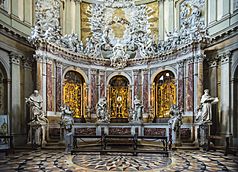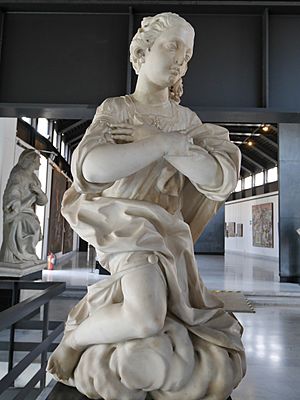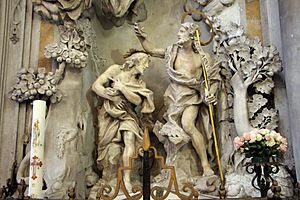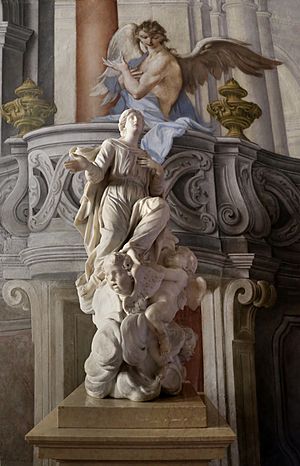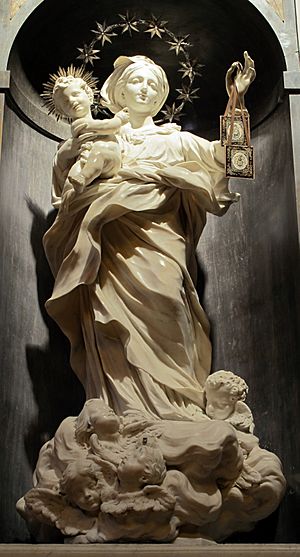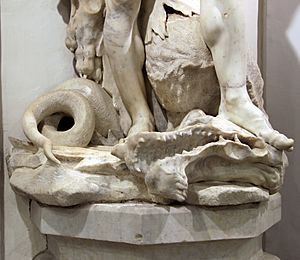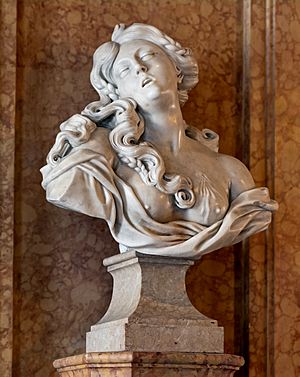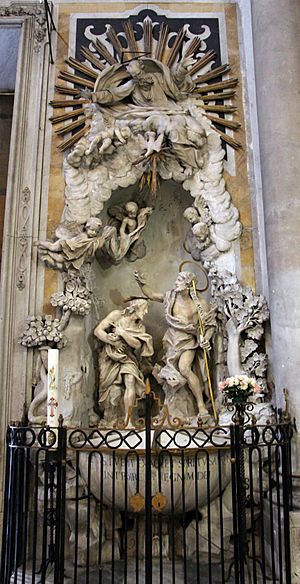Filippo Parodi facts for kids
Filippo Parodi (born 1630 – died July 22, 1702) was a very important Italian sculptor. He lived during the Baroque period, which was a time when art was very grand and dramatic. He is known as "Genoa's first and greatest native Baroque sculptor."
Biography
Filippo Parodi was born in Genoa, Italy. His family was also involved in sculpting. He first became very skilled at working with wood. Later, in the 1670s, he started to create amazing sculptures out of marble.
He traveled to Rome twice, which helped him make his art even better. He worked with a very famous artist named Bernini from 1655 to 1661. He also learned from other sculptors like Alessandro Algardi and Ercole Ferrata. When he returned to Genoa, he met another important French sculptor, Pierre Puget, who was in Genoa from 1661 to 1666. Parodi became very popular and had a large workshop to handle all the sculptures people wanted him to make.
In Genoa, during the 1660s and 1670s, he created several important works. These include an Ecstasy of Saint Martha for Santa Marta church. He also made a Saint John for Santa Maria di Carignano and a Virgin and Child for Santi Vittore e Carlo.
In 1691, he was asked to go to Padua. There, he and his workshop created six white marble sculptures of saints. They also made the impressive Glory of Saint Anthony (1689–97). This work is part of a colorful marble design in the "Chapel of the Treasure" at the Basilica of Saint Anthony of Padua.
In Venice, Parodi completed a detailed funeral monument for Bishop Francesco Morosini in 1678. You can see it in the church of San Nicolò da Tolentino.
For Johann Adam Andreas I von Liechtenstein in Vienna, Parodi made two sculptures that represented ideas. These were busts (head and shoulders sculptures) called Vice (meaning bad habits) and Virtue (meaning good qualities). These sculptures are still in the Liechtenstein Museum in Vienna today.
In 1679, Eugenio Durazzo asked Parodi to create sculptures for the Palazzo Balbi Durazzo in Genoa. These sculptures are still there today in what is now the Royal Palace. They include a sculpture of Christ at the Column for the chapel, which shows strong feelings. He also made four mythological figures for the garden. These figures were from old stories by Ovid, including Venus, Clytie, Adonis, and Hyacinth. Parodi's statues often showed strong emotions and were clever versions of sculptures by Bernini.
Parodi also worked with Giacomo Antonio Ponsonelli, who was also his son-in-law. Parodi's son, Domenico Parodi, became a painter. Domenico first learned from Sebastiano Bombelli. Later, in the 1690s, he worked with famous painters like Carlo Maratta and his student Paolo Girolamo Piola. Some of Filippo Parodi's other students were Angelo de' Rossi, Andrea Brustolon, and the brothers Francesco and Bernardo Schiaffino.
Other works
- Glory of the Magdalene, found at the main altar of S. Maria delle Vigne, Genoa.
- Boy with a Skull (Vanitas), located in the Hermitage Museum in Saint Petersburg.
- Sleeping Christ Child, found at the Cleveland Museum of Art.
- Winter, which is part of a set of sculptures representing the Seasons, also at the Cleveland Museum of Art.
See also
 In Spanish: Giacomo Filippo Parodi para niños
In Spanish: Giacomo Filippo Parodi para niños


